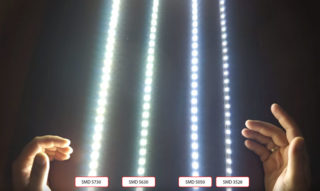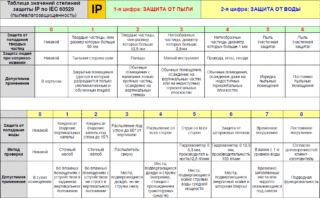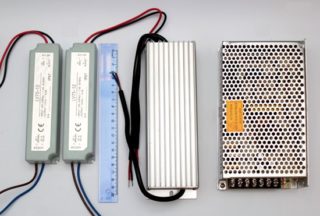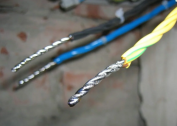Illuminators based on LED strips over time are becoming increasingly popular and are successfully used for various purposes. Today they are used not only for decorating indoor and outdoor spaces, but also for arranging general lighting. In addition, with their help, it is possible to realize the idea of commercial lighting effects that draw attention to billboards and banners. The composition of the power supplies for illuminators, designed for low voltage, includes transformers for LED strips of 12 volts (TP).
Features and characteristics of LED sources
Different samples of LED products differ in a number of ways, the main of which are:
- directivity of the light flux;
- mounting density;
- rated supply voltage;
- degree of protection.
According to the first indicator, well-known samples of LED devices are divided into frontal and end products. The most widespread are tapes with a frontal orientation and a scattering angle of about 120 degrees. Flexible stripes with a lateral source of illumination are not so popular, since their radiation is limited by an angular radius of 90 degrees.
The magnitude of the luminous flux from the LED strip is proportional to the number of emitting elements installed on it per one linear meter. According to the existing classification, this number is selected from the following series: 30, 60, 90, 120 and 240 point units. The supply voltage for low-voltage tapes is either 12 or 24 Volts. Higher values are extremely rare.
Various brands of LED tapes differ in terms of protection against dust and moisture. The protection class is indicated on the product packaging in the form of a combination of the letters IP and the following two digits. The strip with open mounting of diode elements belongs to IP20 class - there is no sealing at all. The tape which is most protected from climatic influences has the highest degree designated as IP68.
How to choose the right TP for LED strip
The main working unit of the power supply unit (PSU) is a voltage converter that lowers the 220 V network voltage to the desired value. Technical parameters according to which a transformer for LEDs is selected:
- the value of the voltage at the output of the device;
- the power that he is able to develop in the load;
- degree of protection of the transformer against moisture.
The supply voltages for which the power supply is calculated are selected at the user's discretion from a number of operating values of 12 and 24 Volts. The output power of the transformer built into it depends on the number of lighting elements connected to the unit. The degree of protection of the structure from moisture and dust is indicated as well as for LEDs (IP20-IP68) and is selected depending on operating conditions.
The advantages of pulse transformers
When choosing a power source that is optimal for operation at home, it is necessary to take into account the following features of the nodes included in its composition:
- A typical transformer for LED strip is made, as a rule, according to a pulse circuit.
- This approach allows you to reduce the size and weight of the power source (UPS).
- At the same time, the efficiency of the entire device as a whole increases.
- To increase the efficiency of the UPS allows an electronic circuit for generating the output voltage with overload protection.
Due to the advantages of pulse transformers, devices made on their basis completely replaced obsolete analog samples.
UPS options
According to their design and performance, power supplies for LEDs are divided into the following types:
- compact network unit that looks like a charger for phones;
- a small module placed in a rectangular elongated housing;
- electronic ballast in a completely sealed box;
- a similar circuit housed in an unpressurized housing of standard size.
Blocks have a small power (30-36 watts), but they are quite cheap. Modules are distinguished by a high power indicator (up to 75 watts). Like the first samples, they are designed to work with decorative lighting, but unlike them, they have a higher cost.
Electronic ballasts in a fully sealed enclosure are designed for operation in harsh climatic conditions. They are used to illuminate billboards and similar products placed on the street. Their leaky counterparts, placed in a standard-sized case, are widely used in everyday life and in work offices. Among modern manufacturers of transformer power supplies, Russian companies MMP Irbis and IPS, as well as foreign Helvar and Mean Well (Taiwan), are especially popular.
UPS power transformer calculation
The initial data for calculating the transformer for the UPS are the lighting parameters that are expected to be achieved through this device. To successfully solve this problem, you will need to determine the length of the ribbon that provides the desired lighting effect. Based on the fact that 60 standard diodes with a total consumption of 4.8 watts are placed on one meter, it is possible to calculate the total power by simply multiplying two known figures. For these purposes, you do not even need a calculator, since all operations are easily performed in the mind.
If it took 10 meters each of 60 LEDs to get a given level of illumination, the total power consumed by them will be 4.8x10 = 48 watts. Given the small margin for this parameter, you should choose a power supply, the power of which is about 50-60 watts.
Features of transformers and their connection
When connecting power transformers, it is important to consider some of the subtleties of this procedure:
- turning on the UPS without the load connected to it is undesirable;
- First you need to connect the LEDs, and then apply voltage to them;
- LED strips need to be connected taking into account the polarity indicated on the substrate.
Another feature of the procedure is the method of connecting loads (individual ribbons). Typical for them is a parallel connection to the UPS output block through a special adapter - its ends are soldered to the contact spots of the tape. However, if the total length of one strip exceeds 5 meters, it is allowed to use series connection. In all other cases, such a connection cannot be called correct, since it will lead to a decrease in the brightness of the glow of the involved LED elements.
To connect an RGB tape to the power supply unit, you will need an additional module that controls the parameters of color elements: their brightness and light intensity. In addition, the device allows you to increase the load capacity of the UPS - it is used as a kind of amplifier.
Homemade transformer power supply for 12 volts
It is easiest to consider the independent manufacture of a transformer power supply for lighting tapes using the example of an analog model in which a typical stabilizer is involved. For its assembly, the following components and parts will be required:
- inductive transformer, reducing voltage from 220 to 15 volts of alternating current;
- rectifier unit based on a diode bridge;
- several filtering elements - capacitors with a capacity of at least 1000 microfarads;
- conventional zener diode and control transistor n-p-n structure;
- stabilizer chip KREN8B, designed for an output voltage of 12 volts.
According to the scheme of a home-made power supply unit, an alternating voltage reduced to the required level is rectified by a diode bridge, after which unnecessary harmonics are filtered out by means of capacitors. A constant voltage of 15-17 volts is then supplied to the output microcircuit, where a stabilized voltage of 12 volts is formed.
Homemade PSU is limited in application and is more suitable for demonstration purposes. For efficient power supply of a branched network of LED strips, an industrial power supply unit with a set of additional functions is required.









